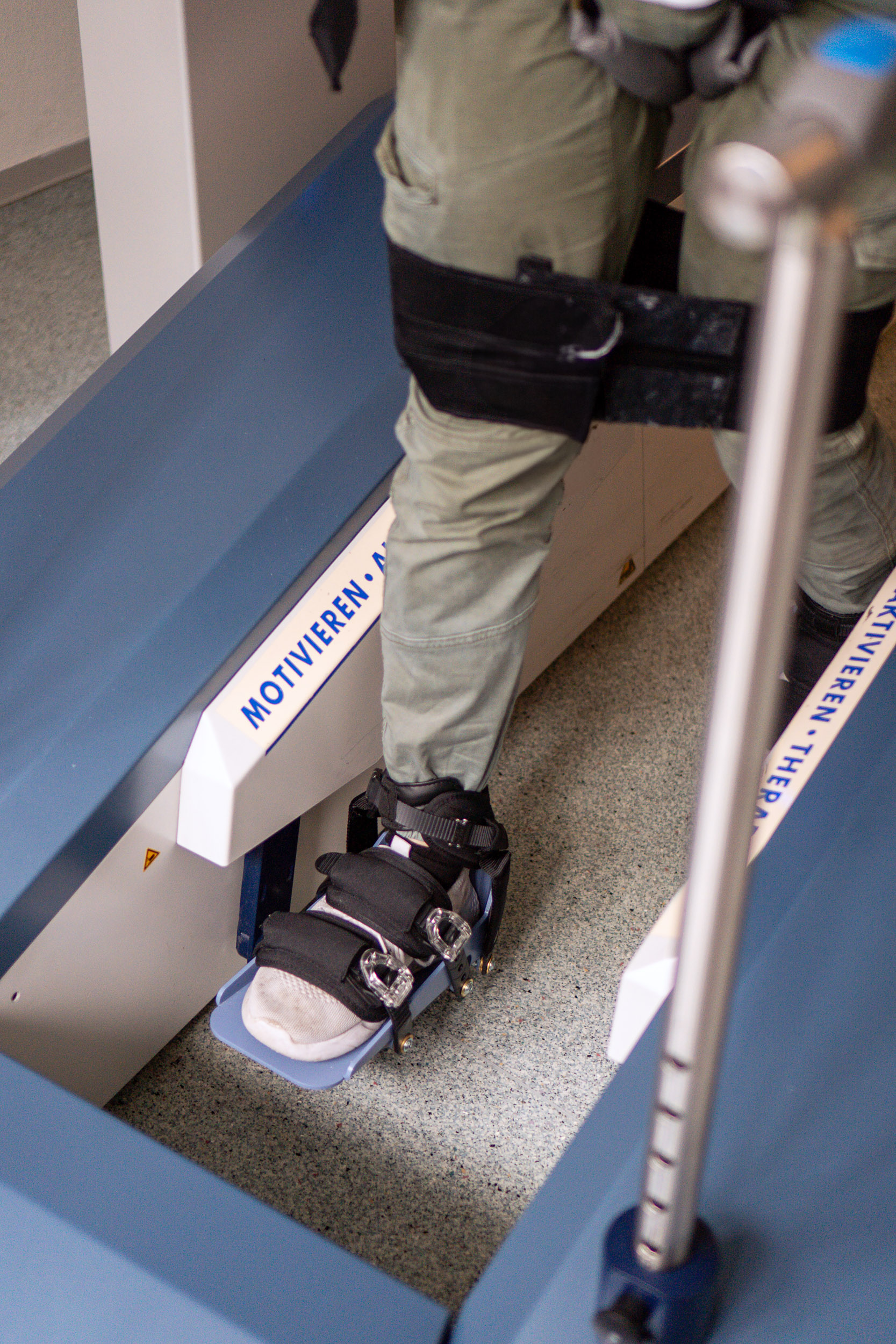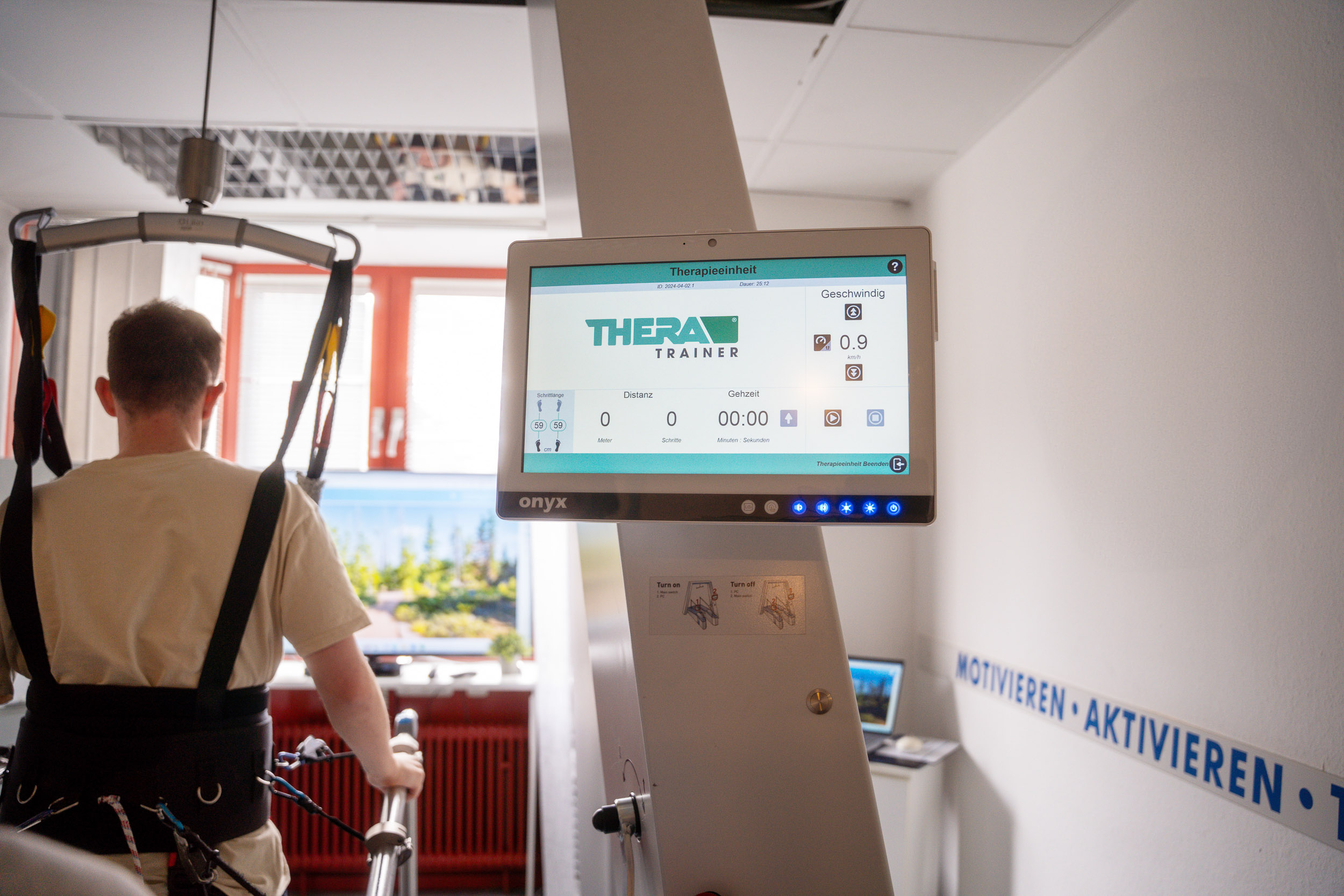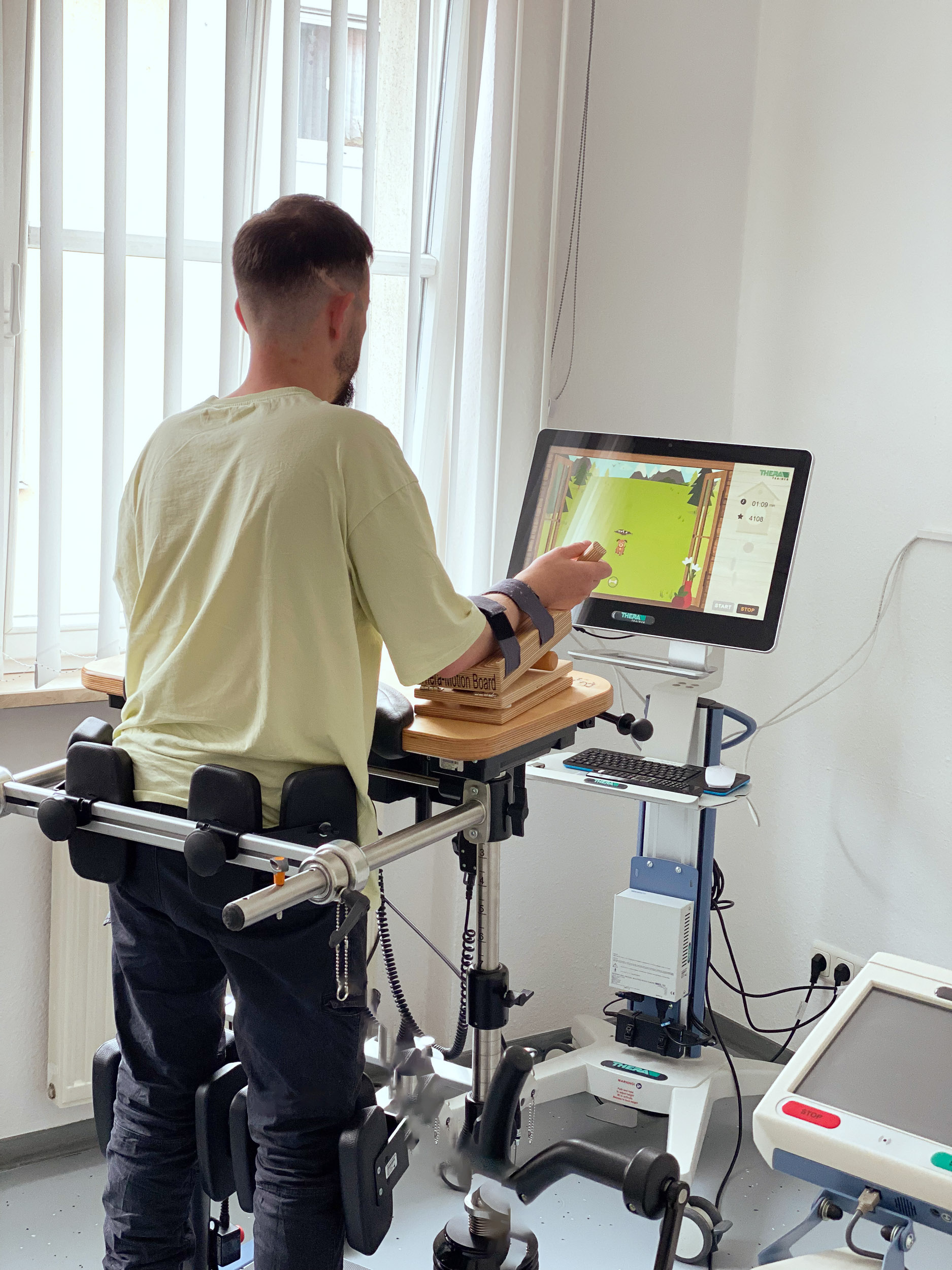
THERAPY Magazin
Back to everyday life, step by step
Discover how innovative THERA-Trainer devices help patients like Timo regain mobility after brain injury. A look inside modern, device-based therapy in neurological rehab.

Leoni Schulz
Eventmanagement and Public Relations, THERA-Trainer
Device-based therapy to regain and improve mobility
After suffering a severe traumatic brain injury in a car accident, Timo is faced with the challenge of relearning many things, including walking. During my visit to the THERAMotion practice in Schweinfurt, I get the opportunity to accompany Timo during his therapy. His physiotherapist, Stefanie Schwarz, guides us through the various exercises and explains how crucial device-based therapy is for restoring and improving his mobility.
At the THERAMotion therapy practice in Schweinfurt, patients with neurological disorders can expect a comprehensively equipped and specialised world of therapy. Here, patients can access a wide range of customised forms of therapy and modern treatment approaches that are tailored to the specific needs of people with neurological challenges. A central element of the treatment concept is device-based therapy to restore and improve mobility. “The ability to stand and walk is one of the most important goals for our patients and an essential prerequisite for regaining the greatest possible independence in everyday life,” explains Stefanie Schwarz, occupational therapist and specialist in neurological rehabilitation.
I have the opportunity to accompany Timo, a young man who is now gradually finding his way back to everyday life after a serious traumatic brain injury in an accident, as he undergoes his therapy session today. At the start of therapy, he stands in a dynamic standing frame. Without the support of this device, Timo would face a high risk of falling when standing. By using the frame, Stefanie can stand a little apart and doesn’t have to worry about securing Timo in the standing position, as the device takes care of this.
The two of them start with everyday reaching and grasping exercises. Timo has asked for a coffee. “I’m afraid I can’t stretch my arm any further, Timo,” says Stefanie, holding the aromatic cup up at a demanding distance. Timo has to twist far beyond his body’s centre line and bend forwards to reach the cup. He’s done it! “Now enjoy your coffee!”
After a few sips of coffee, Timo heads to the next station. His therapy is structured like circuit training, with various training stations where he works on improving his mobility.
Now we have arrived at the senso. Here Timo stands on a pressure-sensitive floor plate that detects his step movements. He receives instructions via a screen on which he plays an interactive therapy game. This motivates him to perform certain sequences of steps repeatedly.
What sounds simple turns out to be extremely challenging. I try it out myself and quickly realise how complex the exercises are. Full attention must be focussed on the screen, while the movements must be almost automatic.
At the THERAMotion therapy practice in Schweinfurt, patients with neurological disorders can expect a comprehensively equipped and specialised world of therapy. Here, patients can access a wide range of customised forms of therapy and modern treatment approaches that are tailored to the specific needs of people with neurological challenges. A central element of the treatment concept is device-based therapy to restore and improve mobility. “The ability to stand and walk is one of the most important goals for our patients and an essential prerequisite for regaining the greatest possible independence in everyday life,” explains Stefanie Schwarz, occupational therapist and specialist in neurological rehabilitation.
I have the opportunity to accompany Timo, a young man who is now gradually finding his way back to everyday life after a serious traumatic brain injury in an accident, as he undergoes his therapy session today. At the start of therapy, he stands in a dynamic standing frame. Without the support of this device, Timo would face a high risk of falling when standing. By using the frame, Stefanie can stand a little apart and doesn’t have to worry about securing Timo in the standing position, as the device takes care of this.
The two of them start with everyday reaching and grasping exercises. Timo has asked for a coffee. “I’m afraid I can’t stretch my arm any further, Timo,” says Stefanie, holding the aromatic cup up at a demanding distance. Timo has to twist far beyond his body’s centre line and bend forwards to reach the cup. He’s done it! “Now enjoy your coffee!”
After a few sips of coffee, Timo heads to the next station. His therapy is structured like circuit training, with various training stations where he works on improving his mobility.
Now we have arrived at the senso. Here Timo stands on a pressure-sensitive floor plate that detects his step movements. He receives instructions via a screen on which he plays an interactive therapy game. This motivates him to perform certain sequences of steps repeatedly.
What sounds simple turns out to be extremely challenging. I try it out myself and quickly realise how complex the exercises are. Full attention must be focussed on the screen, while the movements must be almost automatic.

The ability to stand and walk is one of the most important goals for our patients and an essential prerequisite for regaining the greatest possible independence in everyday life.

I can learn to keep my balance very well (...) I think it’s great
This intervention is called cognitive-motor training. Among other things, it helps you to cope better with everyday dual-tasking situations. Stefanie explains to me what the therapy is all about and what advantages the use of such technologies offers in practice: “We can get patients into the therapy situation quickly and work with a high number of repetitions. The games can also be customised in terms of difficulty.” Another important aspect that Stefanie emphasises is that this training saves a lot of resources, as the patient can practise almost independently and she does not have to be present all the time to ensure efficient and effective therapy.
Timo also shows great enthusiasm for training on the senso. He clearly enjoys the exercises and can already feel the positive effects. “I can learn to keep my balance very well (...) I think it’s great!” he reports. Timo’s progress illustrates how effective cognitive-motor training can be and the benefits it offers in rehabilitation.
The success of the therapy is immediately visible thanks to the module, as it provides precise feedback on how well the training has been mastered. The patient’s progress is presented in the form of an easy-to-understand curve that directly shows which goals have been achieved and in which areas improvements have been made. This transparent presentation of the results enables the patient to clearly understand their own progress, which additionally increases motivation and leads to more committed participation in the further therapy process.
For the next therapy session we use the tigo, a motorised movement exerciser for the legs and upper body. Timo particularly appreciates the opportunity to “cycle through a beautiful landscape at the same time and visualise my progress.” Another significant advantage is that the tigo can be used as an approved aid for the home, as Stefanie Schwarz explains. This enables patients to flexibly and seamlessly incorporate their therapy into their everyday lives, ensuring consistent continuation of treatment and sustainable progress. Even watching the training is fun and makes you want to cycle along yourself.
Timo’s last therapy session is gait training in the lyra. I am impressed by how quickly Timo is secured in the gait trainer and can start training. “With robot-assisted gait training using the lyra, the patient is able for the first time to be continuously guided into the walking movement over a longer period of time thanks to the secured position,” Stefanie explains to me. The end-effector gait trainer is also ideal for maintaining and promoting general mobility. Thanks to the secure attachment, the patient feels protected and can concentrate fully on training. In addition, the patient’s endurance is trained, which makes it possible to carry out increasingly longer therapy sequences.
Through this type of therapy, the physiotherapist can offer their patient efficient and effective ways to get back on their feet and provide quality support to ensure rapid progress. In conversation with Stefanie, I realise once again how valuable these systems are for dealing with staff shortages. The exercises can be carried out more precisely, more frequently and also more independently, which saves the therapists’ resources considerably without having a detrimental effect on the patients. When you watch Timo training in the lyra, you can clearly see the joy in his eyes: “We are friends – for sure!”
“The THERA-Trainer devices can be easily integrated into everyday practice,” explains Stefanie. She emphasises that they are seen as a significant reduction in workload. Timo is also enthusiastic about the training sessions and always looks forward to his therapy. He is impressed by the THERA-Trainer devices and has achieved his first significant progress thanks to this innovative therapy approach – and in a much shorter time. The targeted use of the equipment not only enables him to achieve success more quickly, but also provides a motivating and varied therapy experience.
Timo also shows great enthusiasm for training on the senso. He clearly enjoys the exercises and can already feel the positive effects. “I can learn to keep my balance very well (...) I think it’s great!” he reports. Timo’s progress illustrates how effective cognitive-motor training can be and the benefits it offers in rehabilitation.
The success of the therapy is immediately visible thanks to the module, as it provides precise feedback on how well the training has been mastered. The patient’s progress is presented in the form of an easy-to-understand curve that directly shows which goals have been achieved and in which areas improvements have been made. This transparent presentation of the results enables the patient to clearly understand their own progress, which additionally increases motivation and leads to more committed participation in the further therapy process.
For the next therapy session we use the tigo, a motorised movement exerciser for the legs and upper body. Timo particularly appreciates the opportunity to “cycle through a beautiful landscape at the same time and visualise my progress.” Another significant advantage is that the tigo can be used as an approved aid for the home, as Stefanie Schwarz explains. This enables patients to flexibly and seamlessly incorporate their therapy into their everyday lives, ensuring consistent continuation of treatment and sustainable progress. Even watching the training is fun and makes you want to cycle along yourself.
Timo’s last therapy session is gait training in the lyra. I am impressed by how quickly Timo is secured in the gait trainer and can start training. “With robot-assisted gait training using the lyra, the patient is able for the first time to be continuously guided into the walking movement over a longer period of time thanks to the secured position,” Stefanie explains to me. The end-effector gait trainer is also ideal for maintaining and promoting general mobility. Thanks to the secure attachment, the patient feels protected and can concentrate fully on training. In addition, the patient’s endurance is trained, which makes it possible to carry out increasingly longer therapy sequences.
Through this type of therapy, the physiotherapist can offer their patient efficient and effective ways to get back on their feet and provide quality support to ensure rapid progress. In conversation with Stefanie, I realise once again how valuable these systems are for dealing with staff shortages. The exercises can be carried out more precisely, more frequently and also more independently, which saves the therapists’ resources considerably without having a detrimental effect on the patients. When you watch Timo training in the lyra, you can clearly see the joy in his eyes: “We are friends – for sure!”
“The THERA-Trainer devices can be easily integrated into everyday practice,” explains Stefanie. She emphasises that they are seen as a significant reduction in workload. Timo is also enthusiastic about the training sessions and always looks forward to his therapy. He is impressed by the THERA-Trainer devices and has achieved his first significant progress thanks to this innovative therapy approach – and in a much shorter time. The targeted use of the equipment not only enables him to achieve success more quickly, but also provides a motivating and varied therapy experience.
The THERA-Trainer devices can be easily integrated into everyday practice
Ambulante Rehabilitation
Fachkreise
Therapy & Practice
THERAPY 2024-II

Leoni Schulz
Eventmanagement and Public Relations, THERA-Trainer
Leoni Schulz has been part of the THERAPY Magazine editorial team since mid-2024. As a creative all-rounder, she combines design expertise with strong editorial skills. With her many years of experience in medical technology, she brings practical insights and fresh perspectives to both the layout and the stories she writes.
References:
You need to load content from reCAPTCHA to submit the form. Please note that doing so will share data with third-party providers.
More InformationYou are currently viewing a placeholder content from Turnstile. To access the actual content, click the button below. Please note that doing so will share data with third-party providers.
More Information